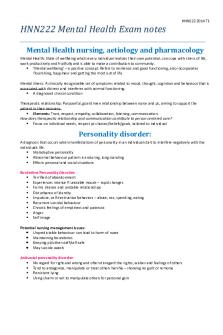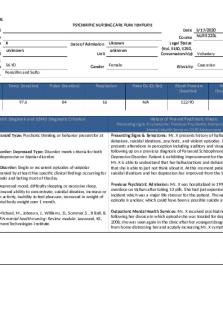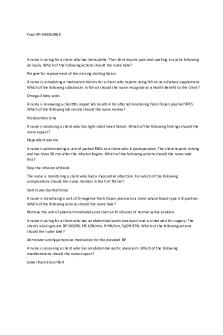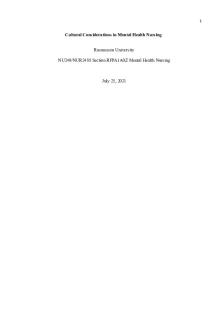ebook for mental health nursing PDF

| Title | ebook for mental health nursing |
|---|---|
| Course | Senior Synthesis |
| Institution | Florida International University |
| Pages | 219 |
| File Size | 4.9 MB |
| File Type | |
| Total Downloads | 8 |
| Total Views | 155 |
Summary
Download ebook for mental health nursing PDF
Description
RN Mental Health Nursing REVIEW MODULE EDITION 10.0
Contributors Norma Jean E. Henry, MSN/Ed, RN
Consultants
Mendy McMichael, DNP, MSN
Susan Adcock, RN, MS
Janean Johnson, MSN, RN, CNE
Katherine McKinley, APRN, FNP-C, MSN
Agnes DiStasi, DNP, RN, CNE
Sheri Stone, MSN, RN, APRN-AGCNS, CCRN, MICT
Kellie L. Wilford, MSN, RN
Deb Johnson-Schuh, RN, MSN, CNE
Terri Lemon, DNP, MSN, RN
Lisa Kongable, MA, PMH-CNS, ARNP, CNE
INTELLECTUAL PROPERTY NOTICE ATI Nursing is a division of Assessment Technologies Institute®, LLC. Copyright © 2016 Assessment Technologies Institute, LLC. All rights reser ved. The reproduction of this work in any electronic, mechanical or other means, now known or hereafter invented, is forbidden without the written permission of Assessment Technologies Institute, LLC. All of the content in this publication, including, for example, the cover, all of the page headers, images, illustrations, graphics, and tex t, are subject to trademark, service mark, trade dress, copyright, and/or other intellectual property rights or licenses held by Assessment Technologies Institute, LLC, one of its affiliates, or by third parties who have licensed their materials to Assessment Technologies Institute, LLC.
RN MENTAL HEALTH NURSING
I
Director of content review: Kristen Lawler Director of development: Derek Prater Project management: Janet Hines, Nicole Burke Coordination of content review: Norma Jean E. Henry, Mendy McMichael Copy editing: Kelly Von Lunen, Derek Prater Layout: Spring Lenox, Randi Hardy Illustrations: Randi Hardy Online media: Morgan Smith, Ron Hanson, Nicole Lobdell, Brant Stacy Cover design: Jason Buck Interior book design: Spring Lenox
IMPORTANT NOTICE TO THE READER Assessment Technologies Institute, LLC, is the publisher of this publication. The content of this publication is for informational and educational pur poses only and may be modified or updated by the publisher at any time. This publication is not providing medical advice and is not intended to be a substitute for professional medical advice, diagnosis, or treatment. The publisher has designed this publication to provide accurate information regarding the subject matter covered; however, the publisher is not responsible for errors, omissions, or for any outcomes related to the use of the contents of this book and makes no guarantee and assumes no responsibility or liability for the use of the products and procedures described or the correctness, sufficiency, or completeness of stated information, opinions, or recommendations. The publisher does not recommend or endorse any specific tests, providers, products, procedures, processes, opinions, or other information that may be mentioned in this publication. Treatments and side effects described in this book may not be applicable to all people; likewise, some people may require a dose or ex perience a side effect that is not described herein. Drugs and medical devices are discussed that may have limited availability controlled by the Food and Drug Administration (FDA) for use only in a research study or clinical trial. Research, clinical practice, and government regulations often change the accepted standard in this field. When consideration is being given to use of any dr ug in the clinical setting, the health care provider or reader is responsible for determining FDA status of the drug, reading the package insert, and reviewing prescribing information for the most up-to-date recommendations on dose, precautions, and contraindications and determining the appropriate usage for the product. Any references in this book to procedures to be employed when rendering emergency care to the sick and injured are provided solely as a general guide. Other or additional safety measures may be required under particular circumstances. This book is not intended as a statement of the standards of care required in any particular situation, because circumstances and a patient’s physical condition can vary widely from one emergency to another. Nor is it intended that this book shall in any way advise personnel concerning legal authority to per form the activities or procedures discussed. Such specific determination should be made only with the aid of legal counsel. Some images in this book feature models. These models do not necessarily endorse, represent, or participate in the activities represented in the images. THE PUBLISHER M AKES NO REPRESENTATIONS OR WARRANTIES OF ANY KIND, WHETHER EXPRESS OR IMPLIED, WITH RESPECT TO THE CONTENT HEREIN. THIS PUBLICATION IS PROVIDED AS-IS, AND THE PUBLISHER AND ITS AFFILIATES SHALL NOT BE LIABLE FOR ANY ACTUAL, INCIDENTAL, SPECIAL, CONSEQUENTIAL, PUNITIVE, OR EXEMPLARY DAMAGES RESULTING, IN WHOLE OR IN PART, FROM THE READER’S USE OF, OR RELIANCE UPON, SUCH CONTENT.
II
CONTENT MASTERY SERIES
User’s Guide Welcome to the Assessment Technologies Institute® RN Mental Health Nursing Review Module Edition 10.0. The mission of ATI’s Content Mastery Series® Review Modules is to provide user-friendly compendiums of nursing knowledge that will: ● Help you locate important information quickly. ● Assist in your learning efforts. ● Provide exercises for applying your nursing knowledge. ● Facilitate your entry into the nursing profession as a newly licensed nurse. This newest edition of the Review Modules has been redesigned to optimize your learning experience. We’ve fit more content into less space and have done so in a way that will make it even easier for you to find and understand the information you need.
ORGANIZATION This Review Module is organized into units covering foundations for mental health nursing, traditional nonpharmacological therapies, psychobiologic disorders, psychopharmacological therapies, specific populations, and psychiatric emergencies. Chapters within these units conform to one of four organizing principles for presenting the content. ● Nursing concepts ● Procedures ● Disorders ● Medications Nursing concepts chapters begin with an overview describing the central concept and its relevance to nursing. Subordinate themes are covered in outline form to demonstrate relationships and present the information in a clear, succinct manner. Procedures chapters include an overview describing the procedure(s) covered in the chapter. These chapters provide nursing knowledge relevant to each procedure, including indications, nursing considerations, and complications. Disorders chapters include an overview describing the disorder. These chapters cover assessments, including risk factors and expected findings, and patient-centered care, including nursing care, medications, therapeutic procedures, and interprofessional care. Medications chapters include an overview describing a disorder or group of disorders. Medications used to treat these disorders are grouped according to classification. A specific medication can be selected as a prototype or example of the characteristics of medications in this classification. These sections include information about how the medication works and its therapeutic uses. Next, you will find information about complications, contraindications/precautions, and interactions, as well as nursing interventions and client education to help prevent and/or manage these issues. Finally, the chapter includes information on nursing administration of the medication and evaluation of the medication’s effectiveness.
RN MENTAL HEALTH NURSING
ACTIVE LEARNING SCENARIOS AND APPLICATION EXERCISES Each chapter includes opportunities for you to test your knowledge and to practice applying that knowledge. Active Learning Scenario exercises pose a nursing scenario and then direct you to use an ATI Active Learning Template (included at the back of this book) to record the important knowledge a nurse should apply to the scenario. An example is then provided to which you can compare your completed Active Learning Template. The Application Exercises include NCLEX-style questions, such as multiple-choice and multiple-select items, providing you with opportunities to practice answering the kinds of questions you might expect to see on ATI assessments or the NCLEX. After the Application Exercises, an answer key is provided, along with rationales.
NCLEX® CONNECTIONS To prepare for the NCLEX-RN, it is important to understand how the content in this Review Module is connected to the NCLEX-RN test plan. You can find information on the detailed test plan at the National Council of State Boards of Nursing’s website, www.ncsbn. org. When reviewing content in this Review Module, regularly ask yourself, “How does this content fit into the test plan, and what types of questions related to this content should I expect?” To help you in this process, we’ve included NCLEX Connections at the beginning of each unit and with each question in the Application Exercises Answer Keys. The NCLEX Connections at the beginning of each unit point out areas of the detailed test plan that relate to the content within that unit. The NCLEX Connections attached to the Application Exercises Answer Keys demonstrate how each exercise fits within the detailed content outline. These NCLEX Connections will help you understand how the detailed content outline is organized, starting with major client needs categories and subcategories and followed by related content areas and tasks. The major client needs categories are: ● Safe and Effective Care Environment ◯ Management of Care ◯ Safety and Infection Control ● Health Promotion and Maintenance ● Psychosocial Integrity ● Physiological Integrity ◯ Basic Care and Comfort ◯ Pharmacological and Parenteral Therapies ◯ Reduction of Risk Potential ◯ Physiological Adaptation An NCLEX Connection might, for example, alert you that content within a unit is related to: ● Psychosocial Integrity ◯ Behavioral Interventions ■ Incorporate behavioral management techniques when caring for a client.
III
QSEN COMPETENCIES As you use the Review Modules, you will note the integration of the Quality and Safety Education for Nurses (QSEN) competencies throughout the chapters. These competencies are integral components of the curriculum of many nursing programs in the United States and prepare you to provide safe, high-quality care as a newly licensed nurse. Icons appear to draw your attention to the six QSEN competencies. Safety: The minimization of risk factors that could cause injury or harm while promoting quality care and maintaining a secure environment for clients, self, and others. Patient-Centered Care: The provision of caring and compassionate, culturally sensitive care that addresses clients’ physiological, psychological, sociological, spiritual, and cultural needs, preferences, and values. Evidence-Based Practice: The use of current knowledge from research and other credible sources, on which to base clinical judgment and client care. Informatics: The use of information technology as a communication and information-gathering tool that supports clinical decision-making and scientifically based nursing practice. Quality Improvement: Care related and organizational processes that involve the development and implementation of a plan to improve health care services and better meet clients’ needs. Teamwork and Collaboration: The delivery of client care in partnership with multidisciplinary members of the health care team to achieve continuity of care and positive client outcomes.
ICONS Icons are used throughout the Review Module to draw your attention to particular areas. Keep an eye out for these icons. This icon is used for NCLEX Connections. This icon indicates gerontological considerations, or knowledge specific to the care of older adult clients. This icon is used for content related to safety and is a QSEN competency. When you see this icon, take note of safety concerns or steps that nurses can take to ensure client safety and a safe environment. This icon is a QSEN competency that indicates the importance of a holistic approach to providing care. This icon, a QSEN competency, points out the integration of research into clinical practice. This icon is a QSEN competency and highlights the use of information technology to support nursing practice. This icon is used to focus on the QSEN competency of integrating planning processes to meet clients’ needs. This icon highlights the QSEN competency of care delivery using an interprofessional approach. This icon appears at the top-right of pages and indicates availability of an online media supplement, such as a graphic, animation, or video. If you have an electronic copy of the Review Module, this icon will appear alongside clickable links to media supplements. If you have a hard copy version of the Review Module, visit www.atitesting.com for details on how to access these features.
FEEDBACK ATI welcomes feedback regarding this Review Module. Please provide comments to [email protected].
IV
CONTENT MASTERY SERIES
Table of Contents NCLEX® Connections 1
UNIT 1
Foundations for Mental Health Nursing
CHAPTER 1
Basic Mental Health Nursing Concepts
3
CHAPTER 2
Legal and Ethical Issues
9
CHAPTER 3
Effective Communication
15
CHAPTER 4
Stress and Defense Mechanisms
21
Defense mechanisms 21 Anxiety 22 CHAPTER 5
Creating and Maintaining a Therapeutic and Safe Environment
25
CHAPTER 6
Diverse Practice Settings
31
NCLEX® Connections 35
UNIT 2
Traditional Nonpharmacological Therapies
CHAPTER 7
Psychoanalysis, Psychotherapy, and Behavioral Therapies
37
CHAPTER 8
Group and Family Therapy
41
Group therapy 41 Families and family therapy
42
CHAPTER 9
Stress Management
47
CHAPTER 10
Brain Stimulation Therapies
51
Electroconvulsive therapy
51
Transcranial magnetic stimulation 52 Vagus nerve stimulation
RN MENTAL HEALTH NURSING
53
V
NCLEX® Connections 55
UNIT 3
Psychobiologic Disorders
CHAPTER 11
Anxiety Disorders
57
CHAPTER 12
Trauma‑ and Stressor‑Related Disorders
63
CHAPTER 13
Depressive Disorders
69
CHAPTER 14
Bipolar Disorders
75
CHAPTER 15
Psychotic Disorders
79
CHAPTER 16
Personality Disorders
85
CHAPTER 17
Neurocognitive Disorders
89
CHAPTER 18
Substance Use and Addictive Disorders
95
CHAPTER 19
Eating Disorders
101
CHAPTER 20
Somatic Symptom and Related Disorders
107
Somatic symptom disorder 107 Illness anxiety disorder 108 Conversion disorder 109 Psychological factors affecting other medicalconditions Factitious disorder
109
110
NCLEX® Connections 113
UNIT 4
CHAPTER 21
Psychopharmacological Therapies Medications for Anxiety and Trauma‑and Stressor‑Related Disorders
115
Benzodiazepine sedative hypnotic anxiolytics 115 Atypical anxiolytic/nonbarbiturate anxiolytics 116 Selective serotonin reuptake inhibitors
117
Serotonin norepinephrine reuptake inhibitors 119 CHAPTER 22
Medications for Depressive Disorders Tricyclic antidepressants
123
123
Selective serotonin reuptake inhibitors
124
Monoamine oxidase inhibitors 126 Atypical antidepressants 127 Other atypical antidepressants
VI
127
CONTENT MASTERY SERIES
CHAPTER 23
Medications for Bipolar Disorders Mood stabilizer
131
Mood‑stabilizing antiepileptic drugs CHAPTER 24
131
133
Medications for Psychotic Disorders
137
Antipsychotics: First‑generation (conventional) 137 Antipsychotics: Second‑ and third‑generation (atypical) 140 CHAPTER 25
Medications for Children and Adolescents Who Have Mental Health Issues 145 CNS stimulants 145 Selective norepinephrine reuptake inhibitor 146 Tricyclic antidepressants
147
Alpha₂‑adrenergic agonists 149 Atypical antipsychotics
149
Selective serotonin reuptake inhibitors CHAPTER 26
151
Medications for Substance Use Disorders Alcohol
155
Opioids
156
155
Nicotine 157
NCLEX® Connections 161
UNIT 5
Specific Populations
CHAPTER 27
Care of Clients Who are Dying and/or Grieving
163
CHAPTER 28
Mental Health Issues of Children and Adolescents
169
NCLEX® Connections 175
UNIT 6
Psychiatric Emergencies
CHAPTER 29
Crisis Management
177
CHAPTER 30
Suicide
179
CHAPTER 31
Anger Management
185
CHAPTER 32
Family and Community Violence
189
CHAPTER 33
Sexual Assault
193
RN MENTAL HEALTH NURSING
VII
References
197
Active Learning Templates
A1
Basic Concept A1 Diagnostic Procedure A3 Growth and Development
A5
Medication A7 Nursing Skill
A9
System Disorder A11 Therapeutic Procedure A13
VIII
CONTENT MASTERY SERIES
NCLEX® Connections When reviewing the following chapters, keep in mind the relevant topics and tasks of the NCLEX outline, in particular:
Client Needs: Management of Care CLIENT RIGHTS: Advocate for client rights and needs. COLLABORATION WITH INTERDISCIPLINARYTEAM: Collaborate with interprofessional members when providing client care.
CONFIDENTIALITY/INFORMATION SECURITY: Maintain client confidentiality and privacy.
ETHICAL PRACTICE: Practice in an manner consistent with a code of ethics for registered nurses.
LEGAL RIGHTS AND RESPONSIBILITIES: Report client conditions as required by law.
Client Needs: Safety and Infection Control ACCIDENT/ERROR/INJURY PREVENTION: Identify factors that influence accident/injury prevention. USE OF RESTRAINTS/SAFETY DEVICES: Monitor/evaluate the client’s response to restraints/safety device.
Client Needs: Psychosocial Integrity COPING MECHANISMS: Assess the client’s ability to adapt to temporary/permanent role changes.
MENTAL HEALTH CONCEPTS: Recognize the client use of defense mechanisms. THERAPEUTIC COMMUNICATION
Assess verbal and nonverbal client communication needs. Evaluate the effectiveness of communications with the client.
THERAPEUTIC ENVIRONMENT: Provide a therapeutic environment for clients.
RN MENTAL HEALTH NURSING
®
1
Online Video: Mental Status Examination
CHAPTER 1 UNIT 1
CHAPTER 1
FOUNDATIONS FOR MENTAL HEALTH NURSING
Basic Mental Health Nursing Concepts
provision of care to clients in mental health settings is based on standards of care set by the American...
Similar Free PDFs
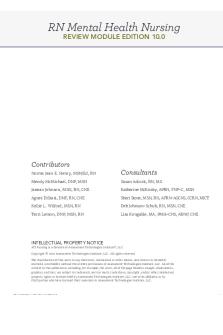
ebook for mental health nursing
- 219 Pages

Uworld Mental Health Nursing
- 168 Pages
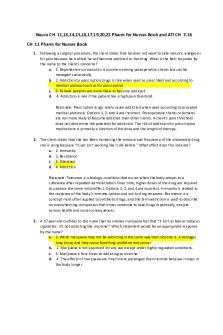
ATI TEST - mental health nursing
- 38 Pages

Viva Questions for Mental Health
- 16 Pages
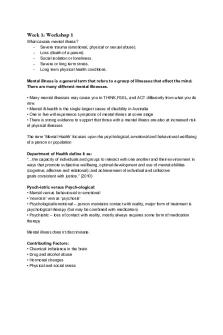
Nursing and Mental Health 1 Notes
- 62 Pages
Popular Institutions
- Tinajero National High School - Annex
- Politeknik Caltex Riau
- Yokohama City University
- SGT University
- University of Al-Qadisiyah
- Divine Word College of Vigan
- Techniek College Rotterdam
- Universidade de Santiago
- Universiti Teknologi MARA Cawangan Johor Kampus Pasir Gudang
- Poltekkes Kemenkes Yogyakarta
- Baguio City National High School
- Colegio san marcos
- preparatoria uno
- Centro de Bachillerato Tecnológico Industrial y de Servicios No. 107
- Dalian Maritime University
- Quang Trung Secondary School
- Colegio Tecnológico en Informática
- Corporación Regional de Educación Superior
- Grupo CEDVA
- Dar Al Uloom University
- Centro de Estudios Preuniversitarios de la Universidad Nacional de Ingeniería
- 上智大学
- Aakash International School, Nuna Majara
- San Felipe Neri Catholic School
- Kang Chiao International School - New Taipei City
- Misamis Occidental National High School
- Institución Educativa Escuela Normal Juan Ladrilleros
- Kolehiyo ng Pantukan
- Batanes State College
- Instituto Continental
- Sekolah Menengah Kejuruan Kesehatan Kaltara (Tarakan)
- Colegio de La Inmaculada Concepcion - Cebu

